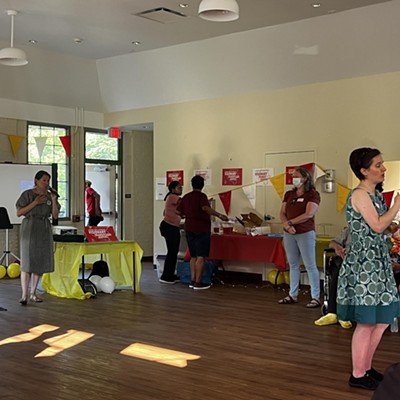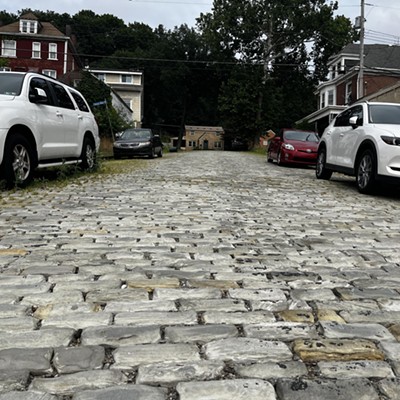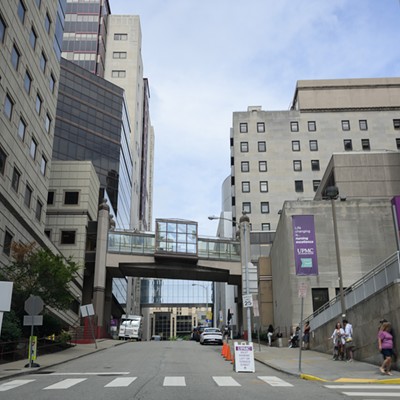Shelf-Reliance: Studying Supermarket Scarcity in Black Areas
[
{
"name": "Local Action Unit",
"component": "24929589",
"insertPoint": "3",
"requiredCountToDisplay": "1"
}
]
The lack of supermarkets in low-income and predominantly black neighborhoods is no myth, says a new study from Carnegie Mellon University.
The recently completed research project by nine students in CMU's H. John Heinz III School of Public Policy and Management (and previewed in "Grocer Inequities," April 16) was led by Beth Daponte, an authority on both food assistance programs and casualties of Middle East wars. Her students examined the economic and racial compositions of every Pittsburgh neighborhood and Allegheny County municipalities, spoke with local community organizers and major grocery chain representatives and examined supermarket location conditions in other American cities, and in all but a few cases confirmed their suspicions about the lack of grocery stores in poor, mostly black areas.
Only 3 percent of Allegheny County grocery supermarkets are located in neighborhoods and municipalities with the lowest average per-capita incomes. In the eight communities with the absolute lowest incomes there were no grocery stores at all. By comparison, the 54 neighborhoods and municipalities with average per capita incomes above $25,000 had 44 percent of county supermarkets. Further, while a third of all county localities -- whether city neighborhood or municipality outside Pittsburgh -- have a black population of over 15 percent, there are only 15 supermarkets among these 64 mostly low-income locales. All of these families in lower-income communities have to travel longer distances to grocery stores -- averaging a 17-minute one-way trip, twice as long as other locales. Low vehicle ownership rates in these same communities aggravates the situation.
The study also found that residents in these underserved communities are more likely to travel far outside their own neighborhood for a grocery store than to shop at a local convenience store. Another popular belief the research debunked: that grocery stores are found where population is densest. A third of all supermarkets are located in the 42 least dense neighborhoods and municipalities. Only 9 percent of the most densely populated areas had supermarkets. And according to the 2000 U.S. census, 8 of the 20 densest city neighborhoods are more than half black; 14 have 20 percent of their families living in poverty. Six of the county's top 20 densest municipalities have more than 20 percent black residents.
One surprising result: Consumers interviewed in food-stamp offices, food pantries, senior centers and even the East Liberty street festival, E-Fest, said a lack of supermarkets in low-income and black neighborhoods meant only that they "generally coped and did not feel going elsewhere to be a large burden."
How do large supermarket chains decide where to locate stores? Chris Fulton, a real estate manager for Supervalu, which owns Shop 'N Save and Foodland, told the CMU researchers that population density is a consideration, along with traffic patterns, while local residents' income is not. A representative of Whole Foods, which opened one of its organic food specialty stores last year in East Liberty, said the chain examines the "psycho-graphics" of a community rather than the demographics, looking for a high concentration of "well-educated buyers who were underserved by existing stores."
The report confirmed the common use of jitneys for grocery-store runs, and found that many major U.S. cities share the same problems. In Philadelphia, for instance, there are 156 percent fewer supermarkets in the poorest neighborhoods than in the richest; there are no chain supermarkets in any of Boston's predominantly black neighborhoods.
The recently completed research project by nine students in CMU's H. John Heinz III School of Public Policy and Management (and previewed in "Grocer Inequities," April 16) was led by Beth Daponte, an authority on both food assistance programs and casualties of Middle East wars. Her students examined the economic and racial compositions of every Pittsburgh neighborhood and Allegheny County municipalities, spoke with local community organizers and major grocery chain representatives and examined supermarket location conditions in other American cities, and in all but a few cases confirmed their suspicions about the lack of grocery stores in poor, mostly black areas.
Only 3 percent of Allegheny County grocery supermarkets are located in neighborhoods and municipalities with the lowest average per-capita incomes. In the eight communities with the absolute lowest incomes there were no grocery stores at all. By comparison, the 54 neighborhoods and municipalities with average per capita incomes above $25,000 had 44 percent of county supermarkets. Further, while a third of all county localities -- whether city neighborhood or municipality outside Pittsburgh -- have a black population of over 15 percent, there are only 15 supermarkets among these 64 mostly low-income locales. All of these families in lower-income communities have to travel longer distances to grocery stores -- averaging a 17-minute one-way trip, twice as long as other locales. Low vehicle ownership rates in these same communities aggravates the situation.
The study also found that residents in these underserved communities are more likely to travel far outside their own neighborhood for a grocery store than to shop at a local convenience store. Another popular belief the research debunked: that grocery stores are found where population is densest. A third of all supermarkets are located in the 42 least dense neighborhoods and municipalities. Only 9 percent of the most densely populated areas had supermarkets. And according to the 2000 U.S. census, 8 of the 20 densest city neighborhoods are more than half black; 14 have 20 percent of their families living in poverty. Six of the county's top 20 densest municipalities have more than 20 percent black residents.
One surprising result: Consumers interviewed in food-stamp offices, food pantries, senior centers and even the East Liberty street festival, E-Fest, said a lack of supermarkets in low-income and black neighborhoods meant only that they "generally coped and did not feel going elsewhere to be a large burden."
How do large supermarket chains decide where to locate stores? Chris Fulton, a real estate manager for Supervalu, which owns Shop 'N Save and Foodland, told the CMU researchers that population density is a consideration, along with traffic patterns, while local residents' income is not. A representative of Whole Foods, which opened one of its organic food specialty stores last year in East Liberty, said the chain examines the "psycho-graphics" of a community rather than the demographics, looking for a high concentration of "well-educated buyers who were underserved by existing stores."
The report confirmed the common use of jitneys for grocery-store runs, and found that many major U.S. cities share the same problems. In Philadelphia, for instance, there are 156 percent fewer supermarkets in the poorest neighborhoods than in the richest; there are no chain supermarkets in any of Boston's predominantly black neighborhoods.














